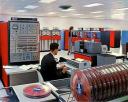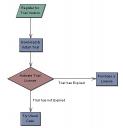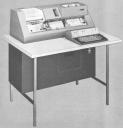The 1970s
While a trainee computer operator position was not what I had wanted, it did get me into
a state of the art data center and finally working with computers.
The Sears Boston data center processed all data for the New England area. They had
had two IBM 360-30 systems and one IBM 360-50 system.
IBM 360-30

IBM 360-50

It was a powerful data center.
Each IBM 360-30 had a card reader for input of punch card data, magnetic tape drives,
high speed printers and paper tape reader.
The IBM 360-50 system had all the same peripherals plus the brand new technology,
magnetic disk drives with removable disk packs.
My trainee position, aka “Tape Ape” consisted of mounting and dismounting magnetic tapes as fast as possible, feeding thousands and thousands of punch cards into card readers as fast as possible, changing boxes of paper on the printers as fast as possible (do I see a pattern) and generally everything to get data into and out of the computers, as fast as possible.
Eventually I was allowed to work on the BIG, POWERFUL IBM 360-50 system, where I got to feed card readers, tape drives, printers and the brand new magnetic disk packs… as fast as possible.
The Sears data center was a 24 hour a day operation, 7 day a week operation.
I was on a rotating shift schedule. 1st shift (8 – 4), 2nd shift (4 – 12 midnight) and 3rd shift (12 – 8). My shift changed every couple of months, so just when I was getting used to the hours, it was time to change.
In the midst of all the crazy shifts, we were married April 4, 1970.
My changing shift schedule meant we often didn’t have the time together we thought we would have. 1st shift, wasn’t bad, we worked the same hours.
3rd shift wasn’t too bad, I would be going to work when she was going to sleep.
2nd shift was the hardest. I left for work before she got home from her job and I got home after she was asleep for the night. We would leave each other notes, like passing ships in the night. This was not how either one of us envisioned our 1st year married.
I spoke with the Sears programmers and my manager about the possibility of moving
into computer programming, instead of operations. It was pretty clear programming was not likely to have any openings, any time soon.
I had managed to get my foot in the door, but the door to computer programming still appeared to be shut.
I did not want to be a “Tape Ape” forever, so it was time to think of what I could do to
get closer to computer programming.
My Father-in-law worked for the Massachusetts Department of Public works, a civil service position. He recommended I take the computer related Mass Civil Service exams, so I could have some chance to get into programming.
One of the benefits of being a Veteran, all veterans got an additional 5 points added to their score on exams. I could, potentially, have a score of 105% on a Civil Service exam.
The way Civil Service exams worked, the higher your score, the higher you were on the list of people called for a particular position. While the extra 5 points did not guaranty you would get a job, you at least had a better chance.
The 1st Mass Civil Service exam I took was for Computer Operator. I passed the exam
and interviewed for a position with the Massachusetts Department of Public Safety (DPS). I got the job!
I started with DPS, working at Mass State Police Headquarters in Boston, near
the end of 1970.
Although I was still a computer operator, and still working shifts, it was clear the chance
for advancement was much better with Civil Service positions then it ever would have been at Sears.
Computer operations for DPS were very different then Sears.
They had two Burroughs B-5500 systems instead of IBM systems.
Burrough B-5500

One of the Burroughs B-5500 systems was used for “batch” processing of jobs, much like Sears had been; cards, tapes, printers, etc.
The 2nd Burroughs B-5500 systems was called L.E.A.P.S., Law Enforcement Agencies Processing System.
L.E.A.P.S. ran 24 hours a day, 7 days a week, 365 days per year. It was very, very rarely down.
L.E.A.P.S. controlled a network of terminals (teletypes), with every local and Mass State Police office connected to it for real-time accessing and communicating of police information.
L.E.A.P.S. was also connected to the Mass Registry of Motor Vehicles D.R.I.V.E.S. system and to the FBI N.C.I.C. (National Crime Information Center).
I continued to take and pass computer related civil service exams, working my way up the ladder.
I moved from computer operations, to a Junior Programmer position at DPS.
My position was as a COBOL (Common Business Oriented Language) programmer, for batch processing applications. The way programming worked then, circa 1972, I would write a “Flow Chart”

of the sequence and logic, write the COBOL code on coding sheets, punch 80 column cards of the COBOL code, compile the program, fix errors and repeat the process until the desired result was accomplished. A small program could take weeks, a large program could take months.
I advanced to Senior Programmer at DPS, then moved to a Systems Analyst position,
circa 1976, at Mass Dept of Correction (DOC), the State Prison System.
DOC was a great place to work, the people were all very positive and good to work with.
While I was working for DOC our Daughter was born in 1977.
There is nothing like having a child to change your perspective, as I would find out.
Not too long after our daughter was born, an unexpected event changed my attitude about DOC.
There was a guard strike at all the Mass State prisons. Much to my surprise, I was told
I was required to fill in for guard duty at one of the prisons, while the guards were on strike.
The prison I was assigned to was MCI Bridgewater, the facility for the criminally insane
inmates!
If had had been single, or married with no children, perhaps I would have felt differently
about this “requirement” of my position in DOC.
I told my manager there was no way was I performing guard duty at a prison.
Not only was it not remotely part of my job, I now had an infant daughter to think about.
I refused to do the guard duty, even though I was told “it’s perfectly safe” and I could lose
my job if I refused. The strike ended within a week or so, but now I knew I wanted no part
of DOC after the way I was treated. I sometimes wonder, if the programmers had gone on strike,
would they have made the guards fill in for the programmers?
At my first opportunity, around the begining of 1978, I took a Programmer/Analyst position
at the Mass Trial Courts. The Trial Courts had a brand new computer facility, with twin
Burroughs B1900 systems. The B1900 was considered to be a “small mainframe”, but it was
still quite powerful for it’s day. The B1900 was the first computer I worked on that
had terminals, basically a monitor and keyboard for input (no mouse, they did not exist) to the system.
Not more punching 80 column cards to get programs created or running.
THAT was a big advancement to my mind. The Trial Courts, although it was the highest paying
State job I had to date, made me realize that I could make a much better income if I got a
job in private industry, so I started looking outside of the State Civil service positions,
for the first time in almost 9 years. In October of 1979, I left the State service and started
as a programmer/analyst with McCormack & Dodge, a computer software company.
In the beginning….
September 17, 2007
My daughter suggested I write a blog about how I got into computers.
My fascination with computers goes back a long way.
The 1960s
The world of computers was very different, over 40 years ago.
Today everyone takes for granted having their own computer, or at least
access to one, at work, at school, at the library, etc. to check email,
look up information, chat with friends, download music, check the stock market
and a million other things. It was nothing like that, back then.
In the 1960s and earlier, only governments and large companies could
afford the multi-million dollar mainframe computers systems, that were,
at the time, the only type of computer that existed. Few people ever say a computer,
except in movies, much less had access to one. No one could even imagine that
a person would own a computer for personal use.
The first computer I saw was at a friend’s workplace, somewhere circa 1963-1965.
The computer (Honeywell, I think) was like something out of a Sci-Fi movie;
flashing lights, lots of switches, spinning tape drives, noisy card readers,
sorters and other high tech (for the 60s) equipment.
I remember thinking, this is SO cool, somehow I have to get into computers.
Then fate, actually Uncle Sam, intervened. I was drafted into the U.S. Army in December 1965.
I had basic training in Fort Dix, New Jersey, followed by Wheeled Mechanic school (trucks, jeeps) also Fort Dix and Tracked Mechanic school (M60/M60A1 tanks, M113 Armored Personnel Carriers) in Fort Knox, KY. Trucks and tanks, no computers at all for me… yet.
U.S. Army M60A1 Main Battle Tank

The Army send to me to Germany, instead of Vietnam, because they needed tank mechanics more in Europe then in Vietnam. I was stationed in Kirch-gons, Germany (aka The Rock), Company B, 2nd Battalion, 33rd Armor, 3rd Amored Division. Nothing much to say about my 18 months in Germany, other then I got to hate the smell (diesel) and noise of the Tanks and I learned to love Germany beer, which I still do.
At the end of my tour of duty in Germany, which was also the end of my active duty, I got
the usual re-enlistment pitch that everyone gets. “We can offer you training for any job
you want, if you re-enlist”, said my company commander. “What are you interested in”?
After thinking for only a couple of seconds, I said, “I want to learn computer programming”.
“Oh, we can’t offer you that”. That was the end of the re-enlistment pitch. I had not
forgotten computers.
When I got back home, November 1967, I then had G.I. Education benefits available to me.
In 1968 I signed up for a Computer Programming and E.A.M. (Electornic Accounting Machines) course, given by the Electronic Computer Programming Institute of Boston. It was a one year
course, covering E.A.M. equipment (card punch, card readers, card sorters, etc.)
IBM key punch

80 column punch card

and programming in R.P.G. (Report Program Generator), IBM assembler and IBM COBOL (Common Business Oriented Langauage). I enjoyed the course immensely and passed with flying colors. With my certificate in hand, I started looking for a job as a computer programmer.
I quickly learned, and I don’t think it’s any different today, companies want experience
more then certificates. It was a real “Catch 22”, if you have experience you can get a
job, if not, you can’t. I got the same results with every application and interview I
had for about a year.
Finally, in late 1969, I had an interview at Sears Roebuck in Boston. I wasn’t offered the
programming job I applied for, but they did offer me a trainee position as a computer operator.
The money was less then I was making at my current job (ouch), so I talked it over
with my soon to be bride. Our wedding was set for April 1970, so taking a new job
with a pay cut, a few months before our wedding, didn’t seem like the greatest idea.
She had faith in me and said, at least it would get my foot in the door.
I started my new trainee computer operator position in January 1970.